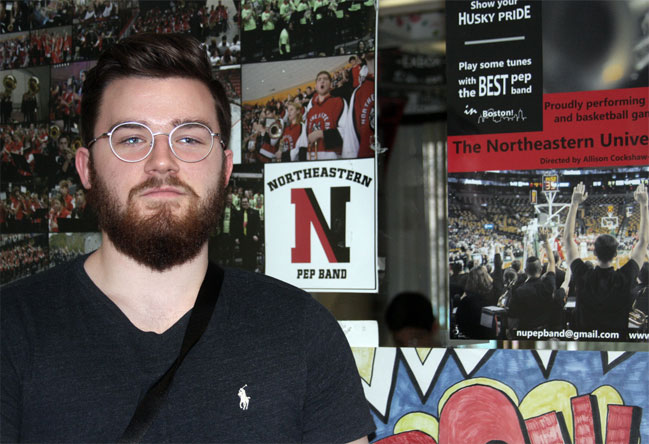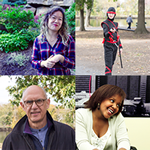Faces Behind the Screen: Gage
Quick Links
<< Return to all “Faces Behind the Screen” stories
We met Gage at the American Sign Language (ASL) Festival at Northeastern University.
Gage is a double major in communication and counseling psychology at Wheelock College. He was first introduced to the Deaf and hard of hearing community when he decided to take an ASL class as the language course for his major in communication.
Although he didn’t know much about it before the course, he immediately became interested in the rich culture of the Deaf community.
Tell us about how taking your first ASL class made you want to sign up for the second.
I took ASL 1 last semester and loved the class and took ASL 2 this semester. And I went in taking ASL because my career path– my original career path– is that I wanted to be a clinical therapist, and I really loved language. And so I took ASL as a language course but soon realized there is much more in the way of culture and cultural competency, and my school stands heavily on social justice issues.
So I stuck through the second course because I just absolutely loved the teacher. I loved everything about the class. It was so rewarding to go there every Friday morning for three hours instead of sleeping in or playing video games. And yeah. And that led me to more opportunities, like what I’m doing now, which is volunteering at the Horace Mann School for the Deaf up in Allston.
How did you find yourself at a sign language festival?
It was my ASL teacher, Charlotte, who kind of enlightened me to this event that’s going on today.
So yeah, it was this long domino effect that got me here, but I absolutely love it. And that’s why I volunteered just to pursue more education in ASL. I’m volunteering in Charlotte’s class, teaching video production, actually, and I’m helping these students with their projects. They produce a news segment, and I’m helping on the technical side with how to produce the films and work the camera, work the computers, operate Adobe and the different programs they use.
“It’s discriminatory not to caption because you’re ignoring a complete culture of people who base their language and communication off of visuals.”
And you mentioned that one of the challenges you’re facing now is closed captioning?
Yeah, in two ways.
Our students produce a bi-weekly news segment [in ASL] called Cougar News through the Horace Mann School for the Deaf. And right now, their current task to tackle is closed captioning for the hearing people who may watch their videos. They do sign their entire news broadcast, and they do have questions that will pop up in text, but that will prompt transition.
They are looking for easy and effective solutions to captioning so that they can produce the videos at the pace that they’re used to without having to slow down to literally type out every word for every frame.
And on my end, I am seeking to do better at captioning my movies that I make. I went into communications because I like making movies, and I just wanted to be able to spend classes making movies.
When I was introduced to Deaf culture and ASL as a language, I realized how important captioning was and how unfair it is that not all visual medium is in captions. Because it’s totally an access issue, and it’s discriminatory not to caption because you’re ignoring a complete culture of people who base their language and communication off of visuals. And we shouldn’t be straying away from film as its original intent as a visual medium.
How do you think we can build more awareness captioning and accessibility?
I think bolstering more Deaf media, Deaf film production.
I just learned about this Ukrainian film recently that is entirely in USL, Ukrainian Sign Language. And it goes all the way back to film as its origin as a visual medium. As an English speaker or even if you speak Ukrainian and don’t understand Ukrainian Sign Language, you can understand the story visually. But for those who do know Ukrainian Sign Language, it is also helpful for the rest of the story.
But it’s a broader topic, because before I took my ASL class I had no idea about the deaf culture, that it even existed. I knew people were deaf, I knew people used ASL, but I didn’t know how important ASL was as a language and how much discrimination the deaf culture has gone through its history here in America, but around the globe. And captioning should be necessary. It shouldn’t just be an add-on that it’s like, oh, well, we have a cool feature, our closed captioning.
That should be a necessity just like everything else. Just like the reason light shines on the screen to show you the movie, there should be captioning for everyone to enjoy the films and enjoy whatever media you’re producing.
“Just like the reason light shines on the screen to show you the movie, there should be captioning for everyone to enjoy the films and enjoy whatever media you’re producing.”
As a videographer, what kind of challenges do you see with captioning. What holds you back from captioning?
For me, as a narrative filmmaker, I think getting the intent of the story across with the pacing. And I think when people see captioning or they hear about captioning, us as Americans, with foreign films, we see captioning, we’re like, “Ugh, we have to read during a movie.”
But it’s more than that. I think it’s about being able to produce a story that’s both visually appealing and that the story itself, through its verbals or its dialogue, is also interesting.
And I think what’s important is to remember that your audience could possibly be everyone, including deaf individuals — so making your film or piece of visual film media as visually stimulating as possible to convey the message. It doesn’t have to just be through the dialogue and through the words told that you have to put block text explaining what your characters are saying on screen. It should drive you to be a better cinematographer or to set up your cameras better to invoke the ideas in the scene, instead of having to explain it to people.
And I think captioning can really enlighten what about your story or what about your film that you’re relying too heavily on spoken word and really try to tell your story the way film is the giving the privilege of, which is telling it visually.
“It’s unfair for them that there’s this piece of art that they can’t fully enjoy because someone didn’t put in the thought to add captions.”
Do you notice that there’s a lack of awareness with other videographers with captioning and accessibility and all that?
There is a theme, yeah. I work at a movie theater, and we have some machines for captioning. And luckily, mass-produced movies, they have their closed captioning with the little machines that go in the cup holder that read out the subtitles. But for more independent film productions, with everybody pressed for time and budget, captions– if that’s not on the forefront of your mind– can slip through the cracks. And that’s completely unfair, because– it’s unfair to both sides, the producers and the people in the audience.
Because for the producers, it’s unfair you’re not reaching the biggest audience you possibly can just by adding one simple aspect to your film. And for the audience, it’s obviously not fair for those who are deaf or hard of hearing that need the captioning to enjoy the story as much as their hearing counterparts.
It’s unfair for them that there’s this piece of art that they can’t fully enjoy because someone didn’t put in the thought to add captions. So I think, when it comes to film festivals and any kind of movie production or any time movies are in a spotlight and people come together who are creators, there needs to be someone or some group there, anybody, to really speak out and acknowledge that we’re not all the way there yet with captioning, with accessibility for all.
And even if there’s movies about social justice and racial issues and religious issues, ablest issues really do slip through the cracks a lot. And I think it’s important to bolster that voice as well, because for those who are deaf or hard of hearing using ASL as their language, it’s not a shared language amongst the hearing community as widespread as other spoken languages. So there really needs to be that voice that bolsters and shows that captioning is extremely vital to media productions.
“Deaf culture is a more collectivist culture apart from our hearing American culture, where we are very much individualistic.”
What kind of things did you learn abut the Deaf community that other people may not be aware of?
I’m not deaf or hard of hearing at all, but I entered into my ASL class and that started me on this whole domino journey of finding different organizations and schools and things like that, communicating with people who are deaf.
[…] I noticed the honesty and upfront nature of the deaf community that I’ve interacted with so far is not being afraid to tell you when you’re wrong… For us hearing people, we can really drown out a lot of something someone’s saying. But for a visual language, especially, things can get distracting if you’re doing it wrong, if you’re not doing the best. But there’s no hard feelings at all. It’s just everyone wanting to be their best they can be.And the Deaf culture is a more collectivist culture apart from our hearing American culture, where we are very much individualistic. Everyone really picks each other up. People that I’ve interacted with really pick each other up and want the best for one another just innately. They’re all there for each other and they’re all supporting. The little production team of students that I have in my class, it’s all hands on deck.
They’re working on editing, writing, being the anchor people, and camera operating. They’re on all different aspects of the production, top to bottom. And that’s what I like to see in a production because you really have an appreciation for every little piece that goes into the puzzle when the product finally comes out. And everyone is held accountable.
—
This page was originally published on 4/19/2017 an was updated 1/17/2018.
We want to extend a huge thank you to Northeastern University for hosting the ASL Festival.
Faces Behind the Screen is a storytelling project focusing on members of the Deaf and hard of hearing community.





